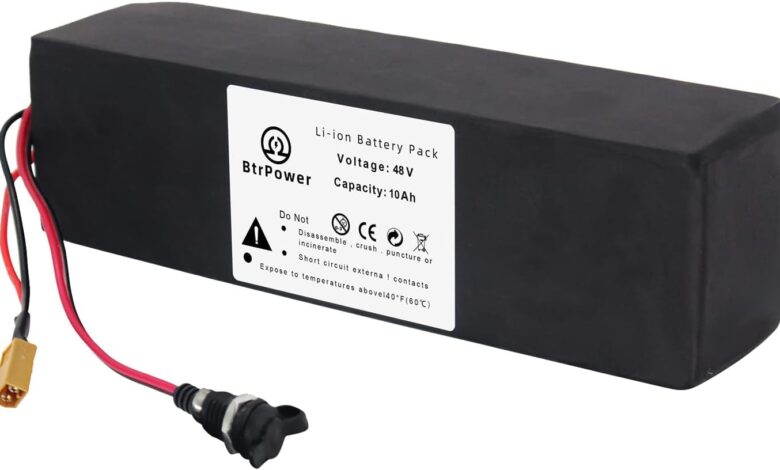Unlocking the Power: A Comprehensive Guide to ebike battery lithium ion

Ebike battery lithium ion E-bikes have transformed the way we commute and explore our surroundings, offering an eco-friendly alternative to traditional transportation methods. At the heart of every e-bike lies its battery, which serves as the powerhouse propelling riders forward. Among the various types of batteries available, lithium-ion batteries stand out as the preferred choice for e-bike enthusiasts due to their numerous advantages. In this comprehensive guide, we will delve into the intricacies of lithium-ion batteries, exploring their composition, functionality, maintenance, and more.
Introduction to ebike battery lithium ion
E-bike batteries are the lifeblood of electric bicycles, providing the energy needed to propel riders forward effortlessly. These batteries come in various shapes, sizes, and chemistries, but one type has emerged as the frontrunner in the industry: lithium-ion batteries.
Lithium-ion batteries have revolutionized the e-bike market with their lightweight design, high energy density, and long lifespan. Unlike traditional lead-acid batteries, which are bulky and prone to premature failure, lithium-ion batteries offer a superior riding experience characterized by extended range and consistent performance ebike battery lithium ion.
Lithium-ion batteries are composed of lithium-ion cells, which contain layers of electrodes immersed in an electrolyte solution. When the battery is charged, lithium ions migrate from the positive electrode (cathode) to the negative electrode (anode), storing energy in the process.
During discharge, the ions flow back to the cathode, generating electrical current that powers the e-bike’s motor. This reversible electrochemical reaction enables lithium-ion batteries to be recharged hundreds of times without significant degradation, making them ideal for use in e-bikes ebike battery lithium ion.
The Evolution of E-Bike Batteries
The evolution of e-bike batteries parallels the rapid advancement of electric bicycle technology over the past few decades. Early e-bikes were powered by cumbersome lead-acid batteries, which were heavy, inefficient, and prone to premature failure.
As demand for e-bikes grew, manufacturers began exploring alternative battery chemistries that could deliver superior performance and reliability. This led to the widespread adoption of lithium-ion batteries, which quickly became the gold standard in the e-bike industry ebike battery lithium ion.
Lithium-ion batteries offer several advantages over traditional lead-acid batteries, including higher energy density, lighter weight, and longer lifespan. These qualities have made lithium-ion batteries the preferred choice for e-bike manufacturers and riders alike, driving innovation and growth in the e-bike market.
Today, lithium-ion batteries come in various configurations to suit different e-bike models and riding styles, ranging from compact and lightweight options for urban commuters to high-capacity batteries for long-distance touring ebike battery lithium ion.
Fundamentals of Lithium-Ion Batteries
To understand the inner workings of lithium-ion batteries, it’s essential to grasp the fundamentals of their composition and functionality. At the core of every lithium-ion battery are one or more lithium-ion cells, which are electrochemical devices that store and release energy through the movement of lithium ions. Each cell consists of several key components, including electrodes, electrolyte, and separators, housed within a protective casing ebike battery lithium ion.
The positive electrode, or cathode, is typically made of a lithium metal oxide compound, such as lithium cobalt oxide (LiCoO2), lithium manganese oxide (LiMn2O4), or lithium iron phosphate (LiFePO4). The negative electrode, or anode, is typically composed of graphite, which acts as a host material for lithium ions during charging and discharging. Separating the cathode and anode is a porous membrane known as the separator, which allows lithium ions to pass through while preventing electrical short circuits ebike battery lithium ion.
When a lithium-ion battery is charged, lithium ions are extracted from the cathode and intercalated into the graphite anode, storing energy in the process. During discharge, the reverse occurs, with lithium ions migrating back to the cathode, generating electrical current that powers the e-bike’s motor.
This reversible electrochemical process enables lithium-ion batteries to be recharged hundreds or even thousands of times without significant degradation, making them highly durable and reliable power sources for e-bikes ebike battery lithium ion.
Advantages of Lithium-Ion Batteries for E-Bikes
Lithium-ion batteries offer several distinct advantages over traditional lead-acid batteries, making them the preferred choice for e-bike manufacturers and riders alike. One of the most significant advantages of lithium-ion batteries is their high energy density, which allows them to store more energy in a smaller and lighter package. This results in e-bikes with longer range and improved performance, enabling riders to travel further on a single charge ebike battery lithium ion.
Another key advantage of lithium-ion batteries is their lightweight design, which enhances the overall maneuverability and handling of e-bikes. Compared to lead-acid batteries, which are bulky and cumbersome, lithium-ion batteries are compact and lightweight, reducing the overall weight of the e-bike and making it easier to navigate through city streets and crowded bike paths ebike battery lithium ion.
In addition to their high energy density and lightweight design, lithium-ion batteries also offer exceptional longevity and durability. Unlike lead-acid batteries, which degrade quickly with repeated charging and discharging cycles, lithium-ion batteries can withstand hundreds or even thousands of cycles without significant loss of capacity. This means that e-bike riders can enjoy reliable performance from their lithium-ion batteries for years to come, with minimal maintenance and upkeep required ebike battery lithium ion.
Types of Lithium-Ion Batteries Used in E-Bikes
Lithium-ion batteries come in various chemistries and configurations, each offering its own set of advantages and disadvantages for e-bike applications. The most common types of lithium-ion batteries used in e-bikes include lithium cobalt oxide (LiCoO2), lithium manganese oxide (LiMn2O4), lithium iron phosphate (LiFePO4), and lithium nickel cobalt aluminum oxide (LiNiCoAlO2), each with its own unique properties and characteristics ebike battery lithium ion.
Lithium cobalt oxide (LiCoO2) batteries are known for their high energy density and relatively low cost, making them a popular choice for consumer electronics and electric vehicles. However, they are prone to thermal runaway and have a limited lifespan, making them less suitable for high-demand applications like e-bikes ebike battery lithium ion.
Lithium manganese oxide (LiMn2O4) batteries offer improved safety and stability compared to lithium cobalt oxide batteries, thanks to their lower cobalt content and higher thermal stability. They also have a longer lifespan and better tolerance to high temperatures, making them a preferred choice for e-bike manufacturers looking for a balance between performance and safety ebike battery lithium ion.
Lithium iron phosphate (LiFePO4) batteries are renowned for their exceptional safety, longevity, and thermal stability, making them an ideal choice for high-performance e-bikes and electric vehicles. They have a longer lifespan and better tolerance to high temperatures than other lithium-ion chemistries, making them well-suited for demanding applications where safety and reliability are paramount ebike battery lithium ion.
Lithium nickel cobalt aluminum oxide (LiNiCoAlO2) batteries offer the highest energy density of any lithium-ion chemistry, making them an attractive option for e-bike riders looking to maximize range and performance. However, they are also the most expensive and least stable lithium-ion chemistry, with a higher risk of thermal runaway and safety issues ebike battery lithium ion.
When choosing a lithium-ion battery for your e-bike, it’s essential to consider factors such as energy density, safety, longevity, and cost, as well as compatibility with your e-bike’s motor and electrical system. Consulting with a knowledgeable retailer or manufacturer can help you select the right battery for your specific needs and riding style, ensuring optimal performance and reliability ebike battery lithium ion.
Factors Affecting the Performance of Lithium-Ion Batteries
Several factors can influence the performance and lifespan of lithium-ion batteries in e-bikes, including temperature, charging and discharging rates, depth of discharge, and maintenance practices. Understanding these factors is essential for maximizing the efficiency and longevity of your e-bike battery, ensuring reliable performance and minimizing the risk of premature failure ebike battery lithium ion.
Temperature sensitivity is one of the most critical factors affecting the performance of lithium-ion batteries. Extreme temperatures, both hot and cold, can have a significant impact on battery efficiency and lifespan, leading to reduced capacity, increased internal resistance, and accelerated degradation. To mitigate the effects of temperature on your e-bike battery, it’s essential to avoid exposing it to extreme heat or cold and to store and charge it in moderate temperatures whenever possible ebike battery lithium ion.
Charging and discharging rates also play a crucial role in determining the performance and lifespan of lithium-ion batteries. Rapid charging and discharging can generate heat and cause stress on the battery cells, leading to increased internal resistance, reduced capacity, and accelerated degradation over time. To prolong the lifespan of your e-bike battery, it’s essential to use a charger that delivers the recommended charging rate and to avoid rapid charging and discharging whenever possible.
Depth of discharge, or the amount of energy drawn from the battery during use, can also impact the performance and lifespan of lithium-ion batteries. Deep discharges, where the battery is drained to low levels of charge, can cause irreversible damage to the cells and lead to reduced capacity and lifespan. To extend the lifespan of your e-bike battery, it’s essential to avoid deep discharges whenever possible and to recharge the battery before it reaches critically low levels of charge ebike battery lithium ion.
Regular maintenance and care are essential for maximizing the performance and lifespan of lithium-ion batteries in e-bikes. Routine inspections, cleaning, and maintenance can help identify and address issues early on, preventing more significant problems down the line. It’s essential to inspect the battery regularly for signs of damage or wear, such as swelling, leaks, or corrosion, and to clean the terminals and connectors to ensure a secure connection and optimal performance ebike battery lithium ion.
In summary, several factors can influence the performance and lifespan of lithium-ion batteries in e-bikes, including temperature sensitivity, charging and discharging rates, depth of discharge, and maintenance practices. By understanding these factors and implementing proper care and maintenance procedures, e-bike riders can maximize the efficiency and longevity of their lithium-ion batteries, ensuring reliable performance and long-term enjoyment of their electric bicycles.
Charging Techniques and Best Practices
Proper charging techniques are essential for maximizing the lifespan and performance of lithium-ion batteries in e-bikes. By following a few simple guidelines, you can ensure that your e-bike battery remains in optimal condition and delivers reliable performance for years to come ebike battery lithium ion.
One of the most important aspects of charging lithium-ion batteries is using the correct charger and charging cable. Different e-bike models may require specific chargers with varying voltage and current ratings, so it’s essential to use the charger provided by the manufacturer or a compatible third-party charger. Using the wrong charger or cable can result in overcharging, undercharging, or damage to the battery cells, leading to reduced capacity and lifespan.
Another crucial aspect of charging lithium-ion batteries is avoiding overcharging and undercharging. Overcharging occurs when the battery is left connected to the charger for an extended period after it reaches full capacity, causing the cells to become overcharged and potentially leading to damage or overheating. Undercharging, on the other hand, occurs when the battery is not fully charged before use, resulting in reduced capacity and range. To avoid overcharging and undercharging, it’s essential to use a charger with features such as automatic shut-off or a charge indicator light that signals when the battery is fully charged ebike battery lithium ion.
It’s also essential to charge your e-bike battery in a well-ventilated area away from direct sunlight and heat sources. High temperatures can accelerate the rate of chemical reactions inside the battery cells, leading to increased internal resistance and reduced capacity. By charging your battery in a cool, well-ventilated environment, you can help maintain optimal performance and extend its lifespan.
Another best practice for charging lithium-ion batteries is to avoid rapid charging whenever possible. Rapid charging, or charging at high current rates, can generate heat and stress on the battery cells, leading to increased internal resistance and reduced lifespan. To minimize the risk of damage from rapid charging, it’s essential to use a charger that delivers the recommended charging rate for your e-bike battery and to avoid charging at excessively high currents.
In addition to proper charging techniques, it’s essential to store your e-bike battery properly when not in use. Storing the battery at full charge or in extreme temperatures can accelerate degradation and reduce its lifespan. Instead, it’s best to store the battery at a partial state of charge (around 50-70% of full capacity) and in a cool, dry environment away from direct sunlight and heat sources. By following these guidelines for charging and storage, you can ensure that your e-bike battery remains in optimal condition and delivers reliable performance for years to come.
Storage Considerations for Lithium-Ion Batteries
Proper storage is essential for maintaining the performance and lifespan of lithium-ion batteries in e-bikes. Whether you’re storing your e-bike battery for the winter or just taking a break from riding, following a few simple guidelines can help ensure that your battery remains in optimal condition and ready for use when you need it.
One of the most important aspects of storing lithium-ion batteries is maintaining the proper state of charge. Storing the battery at full charge or completely discharged state can accelerate degradation and reduce its lifespan. Instead, it’s best to store the battery at a partial state of charge, ideally around 50-70% of full capacity. This helps minimize stress on the battery cells and ensures that they remain in a stable condition during storage.
Another consideration when storing lithium-ion batteries is temperature. Extreme temperatures, both hot and cold, can have a significant impact on battery performance and lifespan. Storing the battery in excessively hot or cold environments can accelerate degradation and lead to reduced capacity and lifespan.
To minimize the effects of temperature on your e-bike battery, it’s essential to store it in a cool, dry place away from direct sunlight and heat sources. Ideally, the temperature should be between 20-25°C (68-77°F), but slightly higher or lower temperatures are also acceptable as long as they remain within a reasonable range.
It’s also essential to protect your e-bike battery from physical damage during storage. Dropping or mishandling the battery can cause internal damage to the cells, leading to reduced performance and safety hazards. To prevent damage, store the battery in its original packaging or a protective case and avoid placing heavy objects on top of it. If possible, store the battery in a secure location where it won’t be subjected to excessive vibrations or impacts ebike battery lithium ion.
You read also more



